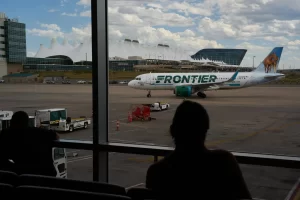CURB Act for environmental justice held up for this session We are sad to report that HB1303 (also known as the CURB Act) will not be moving forward in Olympia this session. We want to thank everyone who supported the bill, address some questions, and explain why this is just a temporary setback. Momentum This
Trump environmental rollbacks would boost pollution and endanger lives, former EPA heads say
Story by MATTHEW DALY WASHINGTON (AP) — Three former Environmental Protection Agency leaders sounded an alarm Friday, saying rollbacks proposed by EPA Administrator Lee Zeldin endanger the lives of millions of Americans and abandon the agency’s dual mission to protect the environment and human health. Zeldin said Wednesday he plans to roll back 31 key
The Supreme Court Holds the Clean Water Act does not Authorize EPA to Include Receiving Water Limitations in San Francisco’s NPDES Permit
In a decision issued last week, the Supreme Court of the United States held that the United States Environmental Protection Agency (EPA) exceeded its authority by including “receiving water limitations” in a National Pollutant Discharge Elimination System (NPDES) permit, siding with the City and County of San Francisco in City & County of San Francisco
Call To Action: HB1303
Act by Wednesday, March 12. Takes less than a minute! Take One Minute To Message Your State Representatives! One of our top policy priorities this legislative session is HB 1303 – also known as the CURB Act – a bill that will improve the State environmental permitting process for projects like the Sustainable Airport Master
Airport and Nearby Communities Partner on Taking Shared Policy Priorities to First-Ever Olympia Day on the Hill
SEA StART members met with state legislators and Executive Branch staff on new approaches to meeting aviation demand while addressing community concerns March 10, 2025 OLYMPIA, WA — Members of the Seattle-Tacoma International Airport (SEA) Stakeholder Advisory Round Table (StART), elected officials and staff from nearby cities, and Port staff traveled to the state capital
The Hidden Economics Behind Those $29 Flights
The perverse incentives for communities under the flight path The Seattle Times recently reported that Frontier Airlines will begin offering three new routes from Paine Field in Everett, Washington starting June 2. The budget airline will connect Everett to Denver, Las Vegas, and Phoenix with flights operating three times weekly. What caught many readers’ attention
Frontier Airlines adds 3 Paine Field routes out of Everett
By Chase Hutchinson Special to The Seattle TimesHeads up, budget travelers: Starting June 2, Seattle Paine Field International Airport will add three new routes from Frontier Airlines, which will fly to Denver, Las Vegas and Phoenix thrice weekly. The new routes, announced Tuesday morning at Paine Field, connect the Everett airport to Denver International Airport (where
Asbestos Northwest
30620 Pacific Hwy S Suite 103 Federal Way, WA, 98003 253-941-4343 Mold Testing Bulk Building Materials and Tape Lifts : Bulk Nonviable Fungal Identification Air Quality Samples: Air sampling and Fungal Spore Identification We are now offering testing for fungal identification, which can help in identifying hazardous types of mold. Bulk samples may be tape
HB1303 continues forward
Environmental Justice/Cumulative Impacts bill moves from Appropriations to Rules During Executive Session on Friday, February 28, HB1303-1st Substitute was voted out of the House Appropriations. As of Monday, it has been moved to the Rules Committee where it waits for a hearing – a final step before obtaining a floor vote and becoming legislation! We
Senate Democrats release tax proposals as budget debate heats up
By Shauna Sowersby Seattle Times staff reporter OLYMPIA — Senate Democrats want to tax Washington’s wealthiest and are calling for a half-cent sales tax cut to reduce the burden on consumers as part of their sweeping package of new revenue proposals. The tax package, released Thursday ahead of the anticipated release of the operating budget






